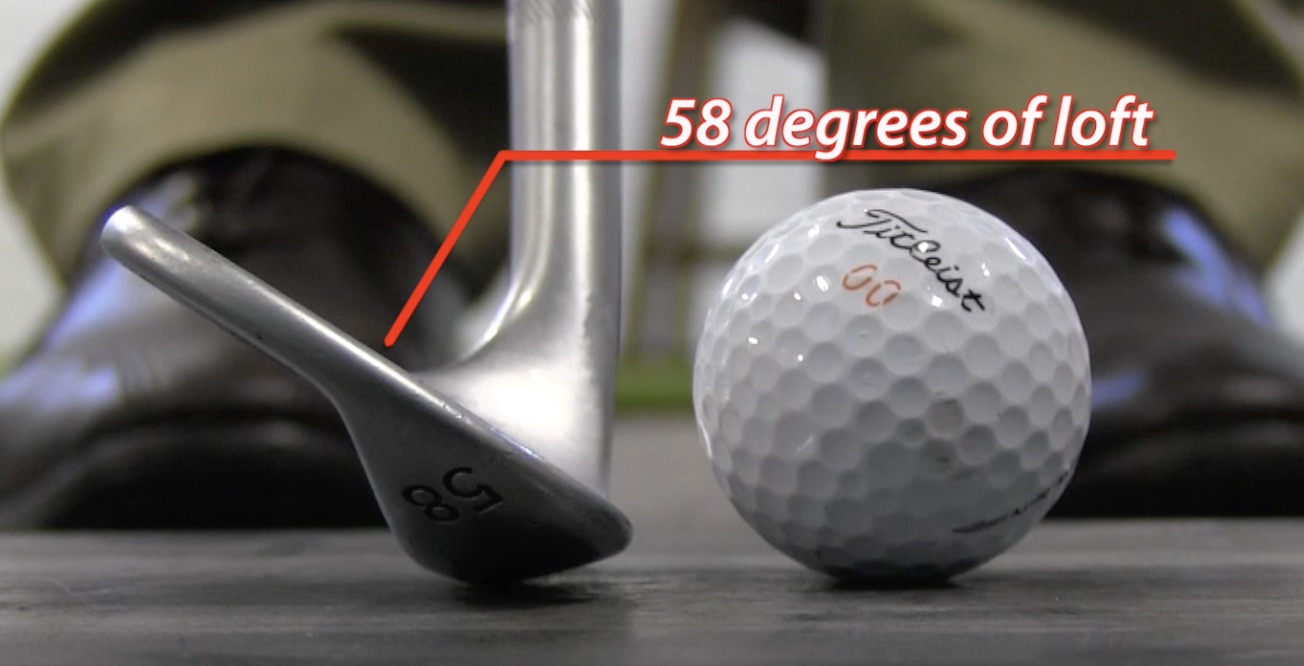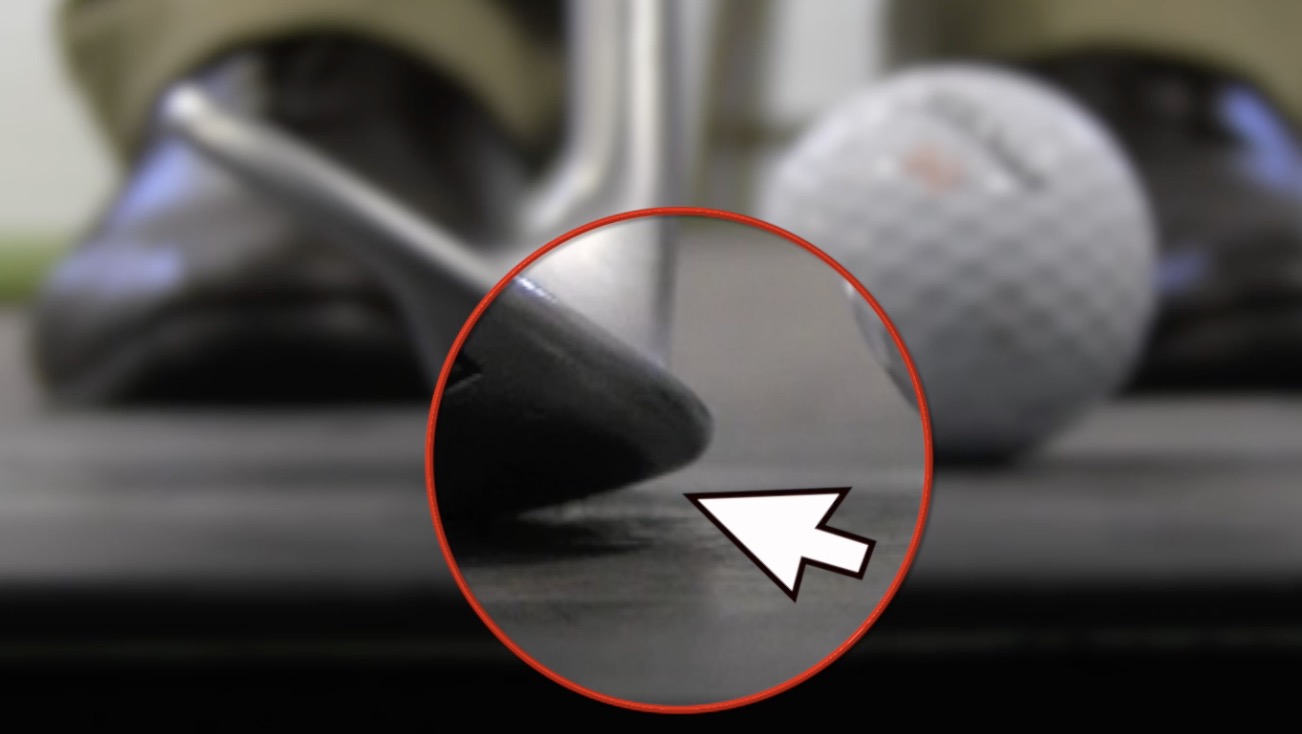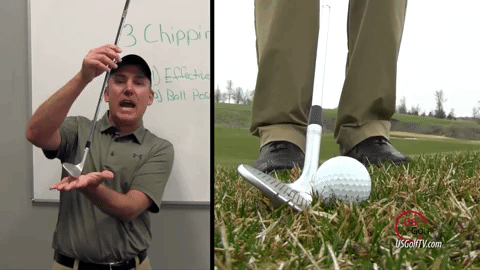The Ultimate Guide To Golf Chipping
Chipping Golf Tips – Chipping Mistakes and the Bad Advice That Comes With Them
Chipping Golf Mistakes: It’s evidently a very popular topic.
After all, everyone wants to chip the ball better.
We’re not all expecting to chip the ball like Jordan Spieth…but still.

Good chipping can turn your round of golf from bad to good quickly. It can take a score from something a hair over 100 to breaking 100. It can take your nine holes from a few strokes over 45, to a few strokes under. Getting the ball closer to the hole helps immensely.
On the PGA Tour, they measure all facets of the game.
Great driving and great iron play are the keys to playing great rounds of golf. But efficient chipping holds those rounds together.
And chipping isn’t always so easy.
PGA instructor Todd Kolb—the Teaching Director at USGolfTV—has been working with golfers on their game for over 25 years. Through the years, he’s seen it all around the greens. He’s seen the duffs and shanks. He’s seen many skulls. And he’s witnessed golfers struggle with their chipping. And these are the 3 biggest chipping mistakes he sees on a regular basis.
The Worst Chipping Mistakes Come From the Best Intentions
People think they know how to fix their chipping. But many of the pieces of advice moving through golf circles are flat out wrong. They are doing the opposite of helping golfers improve. They are hurting golfers. These tips are making them worse. How are you supposed to fix chipping mistakes when they’re presented as tips??
You’ve heard it before…
“Put the handle of the club (and hands) in front of the ball.”
“Put the ball back in your stance!”
“Just hit DOWN on the golf ball. The loft will pop it in the air…”
This leads to a host of errors that compound on one another.
At the end of the day, we want to help golfers eliminate those poor shots from their arsenal.
Decades of observation and years of study later, Kolb has narrowed down chipping mistakes to three common areas. And instead, he’s developed three ways to fix those chipping mistakes.
They are highlighted in the video below:
3 Common Chipping Golf Mistakes
Golf Chipping Mistake #1: Poor Use of Effective Loft & Bounce
Every wedge is designed with an invention from the great Gene Sarazen.
It’s a little thing called “bounce.” (And if you don’t know what bounce is, here’s a great video from yours truly in 2015 explaining bounce with crazy hair)
But aside from just bounce, every club has loft.
Every wedge has both bounce and loft.


“Bounce is the curve on the bottom, and it’s the best invention in wedges.”
–Todd Kolb, Director of Instruction at USGolfTV
Now when we hear that classic snippet of advice to “put your hands forward,” it removes both of these elements of the wedge. Putting your hands forward changes the loft of the club (taking a 56 degree down to 53 degrees). It also removes the bounce on the wedge. The curve on the bottom of the wedge isn’t able to interact with the turf anymore.
Both the bounce and the loft on the wedge are designed to help you!
Unlike this…

The Fix: Create more of a vertical angle with the shaft at address. Eliminate the forward press.
Old Advice: “Handle in Front”
You have most likely been told that the secret to chipping is to position the handle of your club out in front of the golf ball. It is also likely that this advice has hurt your chip shots.
When you hold the handle out in front of the ball, you de-loft the club. That is to say, you tilt the club face so it is more or less perpendicular to the ground. This advice also causes you to negate the bounce. By tilting the face of the club forward, the curve that creates bounce completely disappears. While you technically can chip this way, you do so with a much smaller margin of error, as the club will not bounce through the turf.
In other words, when you follow this advice, you have to hit to the ball in the exact right spot at the exact right moment in order to get a decent chip.
Now, many golfers will immediately reference the wrist hinge and hold method popularized by Phil Mickelson. We would never say Phil is chipping wrong. But what works for a world-class athlete with unbelievable hand-eye coordination might not work for the average golfer playing a few times a month. The goal here is consistency; create a shot that is consistent in reliable.
Better Advice: Neutral Shaft Angle
Club manufacturers design clubs with a neutral shaft angle in mind. More specifically, your club was scientifically designed to help you get the most out of each shot so you don’t have to swing from unnatural positions.
If you want to start making better chip shots, the first rule is easy: trust the club.
Golf Chipping Mistake #2: Incorrect Ball Position
It’s been said on practice greens for years. People have been hearing this forever. “Put the ball back in your stance.”
But putting your ball back in your stance sets up for failure.
99% of golfers, when they move the ball back in their stance, leave the handle and their hands in the same place. Doing this de-lofts the golf club, removing the effective loft. It also negates any of the bounce.
Moving the ball back in the stance hurts your chipping more than it helps.

Old Advice: “Ball Back”
Very common advice suggests that a solid chip shot requires you to set the ball back further in your stance, away from the target and possibly even behind your trail foot. However, this setup is likely to force the handle forward, which, as we know, will cause you to tilt your clubface forward as well, eliminating the loft and negating the bounce.
Better Advice: Center the Ball
Set up with your feet close together and your ball in the center of the stance. You can place the ball slightly back in your stance if that works for you. Just be careful not to set it too far back. Remember, you do not want the handle of your club to come out in front of the golf ball. Use the natural position of your handle to gauge whether or not you’ve place the ball too far towards your trail foot.
Golf Chipping Mistake #3: Inconsistent Chipping Motion
“Hit down on the ball…”
To be clear, that is not correct.
Now the club has a descending blow as it makes contact with the ball, this is true. Technically, the club travels down as it moves into impact, yes. But hitting “down” on your chips is not the correct way to be thinking of your chipping. You need to be thinking about hitting your chips with a descending blow. Down and through is more appropriate.
By understanding that you need to hit down and through your chips, the club won’t get stuck at impact. You hopefully won’t be digging the club into the turf as you come into impact. Down and through the chip, utilizing both the effective loft (above) and bounce (above, too).

Old Advice: “Hit Down on the Ball”
The error in this advice is not the advice itself, but rather, the way someone phrases the advice. Most people translate “hit down” to mean “swing at the ground.” They visualize a motion that stops at the bottom of the swing.
Better Advice: Use a Descending Motion
“Down blow” and “descending blow” may seem like identical concepts, but our brains have a nuanced definition of each, whether we realize it or not. Approach your chip shot with the intention of catching the ball on a descending motion, and you are more likely to not only make contact with the ball at the correct angle, but also continue that motion all the way through the swing, rather than sending a message to your body that the swing ends at the ground.
The One Key Tip to Help Your Chipping Technique
The key to good chipping is to focus on the movement of the butt end of the club.
When you start your backswing and take your club head back to hit a chip shot, you need to also move the butt end of the club with it. Now don’t misunderstand. This is not to say the club head and the butt end move the same amount during a chip shot. We all know this would be impossible. But the butt end must move backward at the start of the chipping motion.
“The initial movement away from the ball, if you can move the butt end and the handle at the same time, you will maintain both your effective loft and your bounce throughout the chipping motion.”
– Todd Kolb
The Secret Backswing Move to Improve Your Chipping
Not only do you need to start the handle and club head in the same direction in the backswing, you need to work straight back. A big reason the average golfer struggles with their short game is that they work the club around the body. What often happens is the club face opens up and causes shanks, or we chunk behind the ball or blade it across the green.
Instead, think of a catcher’s mitt behind you at address. As you make your chipping stroke, simply move the club straight back into the “mitt” behind you, keeping that club face relatively square in the backswing. Then simply bring the club straight through for better contact and better chip shots.
Buy a Chipping Net for Your Short Game
One of the best ways for a golfer to improve their short game is to work on their short game. Buy an affordable golf chipping net, work on a proper swing path and get a proper feel for this short shot. You may not get a feel for distance control with no roll out, but it will certainly help you learn how to work on your landing spot for the shot.
Do You Have the Yips?
Chipping yips can plague any level of golfer, so here are some simple grip changes you can do to improve your chipping game:
- Hold the club with the same grip you would for your putter. This creates more of a putting stroke and reduces some wrist movement, and also helps with the direction of the swing path. The club head works more straight back and through, instead of working around the body.
- Hit shots with your dominant hand only (Right arm for right-handed golfers, left arm for lefties). This is also a popular chipping drill we like to use, and it helps golfers learn how to properly use the bounce
- Chip Lead Hand Low, meaning your lead hand is below your trail hand on the grip. This is becoming a more popular putting style, but works for chipping too. This helps eliminate the wrist action in your golf swing, helping to prevent digging or flipping at impact.
Chipping Golf Mistakes Do Not Have to Continue
While there are a plethora of other chipping mistakes we didn’t cover, these are the biggest culprits we see. If you have a chipping mistake we didn’t cover, let us know one you see amateurs making!
We sincerely help this video and this instruction helps you with your chipping and helps you play better golf. Hopefully it identifies one of the chipping mistakes you may be making yourself.
Please send us a message if you’ve tried this. Especially if it has helped you. And here are 3 Chipping Tips to help you around the greens!
COMMENT BELOW!
Something to consider…#golf #coaching #tkga pic.twitter.com/LFo2sAVuGX
— Todd Kolb (@toddkolbgolf) May 13, 2017


Troy, the chipping video was great. My question, on the downward swing do we hinge the wrists or are they sort of quiet.? Do you have a putting video?
Kevin, thank you and great question!
During the chipping motion, I’m not quite sure I understand your question? The wrists should be fairly quiet through impact. You want to bring the club back to the general position that it was at impact. Let us know if that doesn’t help.
If you’re looking for videos on putting, we just released a video last week about putting setup: https://www.youtube.com/watch?v=hhZxm-caEeY&t=263s
Enjoy!
My question is this: if you correct these mistakes where should the swing end? Hit ball first or hit grass first or do you tuck the club between ball and grass. And follow thru.
When I chip, If I keep the handle vertical, (stright up and down), I tend to get double hits. If I lean the club slightly forward it doesnt happen.
A little bit of forward shaft lean is ok. Make sure your weight is also on your lead foot. Check this out https://youtu.be/Dz8NF59xh_0